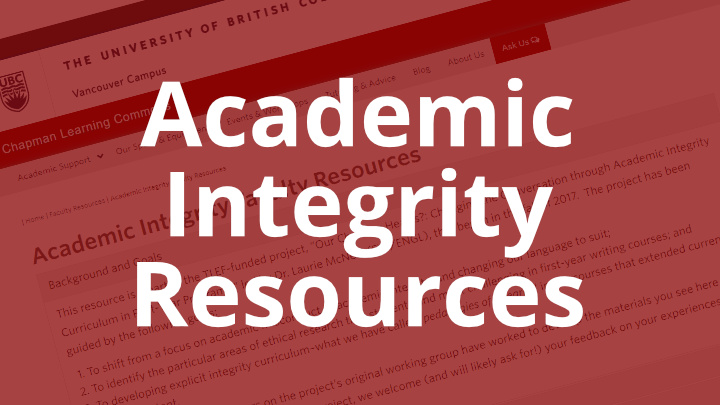Teaching Academic Integrity
Upholding and promoting academic integrity at UBC.
Instructors and teaching assistants are students’ primary sources for learning about academic integrity. There is a range of resources, advice, and ideas to help build academic integrity into courses. In particular, these approaches build from the principle that instructors have a responsibility to teach academic integrity in every course, at every level.
Instructors at UBC are encouraged to provide a syllabus statement of academic integrity, discuss academic integrity early and often in their course, and design assignments that cultivate and reward academic integrity. If you need a starting point, have a look at our Academic Integrity Statement.
Things to reflect on
Why is integrity important in your discipline?
What do you want students to know about academic integrity?
To what extent does your course design suggest to students that academic integrity is important?
What is your responsibility for teaching academic integrity?
Academic Integrity and Student Wellbeing
It is essential to recognize that students often commit misconduct because they are dealing with non-academic issues. These can be due to medical or personal crises, or failing to master the academic work habits that they need to do their work in timely and effective ways (project management, time management, note-taking, research skills, etc.). In your syllabus and on your Canvas site, include links to resources that students in these situations could consult.
Ideally, talk about these resources in class too; right before mid-terms and near the end of the course would be “just-in-time” reminders that students may need. Students have varying levels of awareness about UBC’s standards for academic integrity due to differences in past educational experiences. This is why teaching academic integrity is a crucial step in making them responsible and thriving members of the learning community.
Approaches for Teaching Academic Integrity
Promoting academic integrity in the classroom
Academic integrity should be an ongoing conversation with students, rather than a one-time notification. Instructors are encouraged to incorporate discussion about academic integrity into each of their courses. The resources provided here provides ways to continually remind students about academic integrity at UBC.
Have a look at our Teaching Academic Integrity handout from the CTLT Spring Institute 2022.
Use the syllabus statement
Providing a clear, accurate, and explicit statement about how you expect your students to do their work in your course with integrity, and why, is an easy way to establish a framework of integrity from the very beginning. The components of an effective syllabus statement are:
- Begin with a rationale, stating why academic integrity matters — in this course, at UBC, in the wider scholarly community — and why you commit to taking it so seriously.
- Articulate, briefly, what working with integrity looks like: acknowledging others’ work you draw upon, for example, or submitting accurate data.
- Provide examples of what violations of academic integrity look like by highlighting the issues that are most common.
- State how cases of suspected misconduct will be addressed, for example through a statement such as “all cases of suspected misconduct will be investigated and reported to the Department Head.”
- Include links to resources to help students know more about the expectations and policies, and how to get help to meet those expectations.
An editable Word document is available to assist you in creating your syllabus statement (docx).
Discuss academic integrity early and often
While a syllabus statement on academic integrity is a great start, this foundational idea needs to come “off the page” and live in your course in a meaningful way. Otherwise, students may gloss over it as just another course policy rather than a key expectation of how they do their work.
Discuss academic integrity with your students:
- Define what it looks like, or what forms of it are most common in relation to your class.
- Share information about how contract cheating companies work.
- Provide resources — such as time management, research, and student services guides — to help students see better options.
Design assessments accordingly
Academic activities broadly fall into the categories of creative pursuits and production of knowledge (e.g. writing a paper) and demonstrating knowledge (e.g. tests).
For each assignment, include explicit academic integrity evaluation criteria on the instruction sheet or rubric.
Give time in class for discussion and questions about how to work in ways that meet the expectations of academic integrity. Get students to problem-solve, especially for assignments — such as group work, online tests, or oral or visual presentations – that they may not have done before, or that present particular challenges, such as:
- What does academic integrity look like in this application?
- What are the challenges?
- What are the solutions and strategies we could use to ensure academic integrity?
Instructional Practices

Make academic integrity a learning outcome
This strategy reinforces that this expectation is not a minor “rule” but a foundational part of the learning students will need to demonstrate in the course.
Find examples of statements on Academic Integrity Faculty Resources.

Facilitate an activity about academic integrity
In a discussion or low-stakes activity, have students define academic integrity and why it matters to them. This activity can lead to a group agreement or class charter, or simply provide an opportunity for them to think about what this concept means, and ask questions about it.
Find an example of such an activity on Academic Integrity Faculty Resources.

Learning activities
Require students to complete academic integrity activities or readings as a prerequisite to submitting their first assignment. The Academic Integrity Modules are a good place to start. Students who complete this course receive a downloadable certificate that can be attached to an assignment or submitted to you. Another exam
Find an example of an academic integrity quiz.
Academic Integrity for Teaching and Learning keynote video
Academic integrity and EDI: Rethinking Pedagogy and Practices


